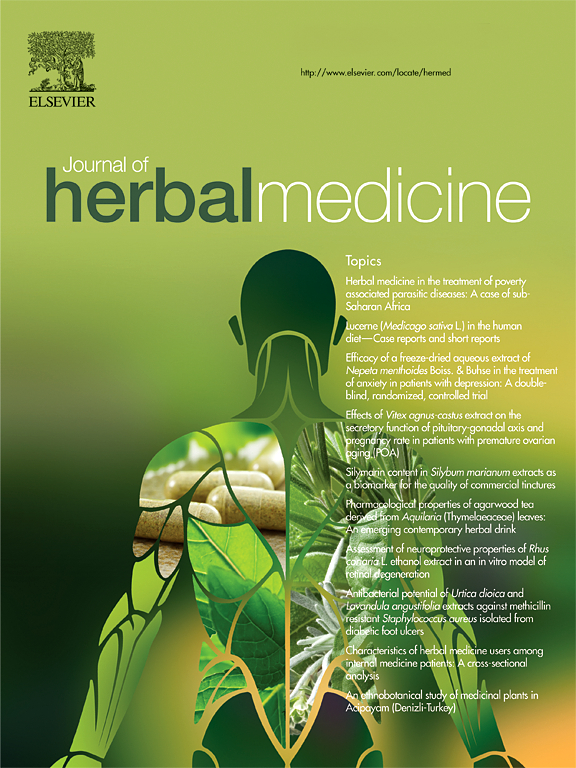Assessment of antibacterial, antioxidant, cytotoxic properties and chemical composition of Oenanthe javanica (Blume) DC. essential oil
IF 1.9
4区 医学
Q2 INTEGRATIVE & COMPLEMENTARY MEDICINE
引用次数: 0
Abstract
Introduction
Bacterial food-borne diseases have been a major public health issue worldwide for decades. Oenanthe javanica (Blume) DC. is a small perennial herb of family Apiaceae, commonly found in Asia. The present study aims to evaluate the antibacterial, antioxidant, and cytotoxic capabilities, as well as the antibacterial mechanism of action, of Oenanthe javanica essential oil (OJEO).
Methods
In-vitro antibacterial activity was evaluated by Disc diffusion and microbroth dilution methods against Salmonella enterica serovar Typhimurium (ATCC 14028). Flow cytometric analysis was done to assess the effects of oil on membrane integrity and membrane potential. Electron Microscopy (SEM and TEM) was done to investigate morphological and intracellular damages initiated by the oil. Phytochemical profiling of oil was done by Gas Chromatography Mass - Spectrometry (GC-MS). Anti-proliferative property of OJEO was measured against 5 proliferative cell lines by MTT and NRU assay.
Results
OJEO exhibited encouraging antibacterial activity against Salmonella enterica serovar Typhimurium (ATCC 14028); MIC and MBC values were 1000 μg/mL and 1500 μg/mL, respectively. Oil treatment compromised bacterial membrane integrity and led to a decreased bacterial membrane potential. (SEM) and (TEM) analyses confirmed oil induced morphological and intracellular damage. Phytochemical characterization affirmed 47 components with β-pinene (11.29 %), γ-terpinene (32.55%), p-cymene (20.83%), α-terpinolene (7.42 %), myrcene (2.09 %) as major chemical constituents. Oil had moderate antiproliferative activity against A549, MCF-7, HaCat, HCT116 and HepG2 cell lines.
Conclusion
This study illustrates the significant antimicrobial, antioxidant, and cytotoxic properties of OJEO, indicating its potential as a therapeutic agent for bacterial diseases. Food systems and associated industries may utilise OJEO as a natural solution for combating food-borne bacteria and as a preservative agent.
水芹的抗菌、抗氧化、细胞毒性及化学成分研究。精油
几十年来,细菌性食源性疾病一直是世界范围内的一个主要公共卫生问题。oenanjavanica (Blume) DC。是一种菊科多年生草本植物,常见于亚洲。本研究旨在评价爪哇精油(OJEO)的抑菌、抗氧化、细胞毒作用及其抑菌机制。方法采用圆盘扩散法和微肉汤稀释法评价其对肠炎沙门氏菌血清型鼠伤寒杆菌(ATCC 14028)的体外抗菌活性。流式细胞术分析了油对膜完整性和膜电位的影响。电镜(SEM)和透射电镜(TEM)观察了油引起的形态学和细胞内损伤。采用气相色谱-质谱法(GC-MS)对油脂进行了植物化学分析。采用MTT法和NRU法测定了OJEO对5种增殖细胞系的抗增殖性能。结果sojeo对肠炎沙门氏菌血清型鼠伤寒菌(ATCC 14028)具有较强的抑菌活性;MIC和MBC分别为1000 μg/mL和1500 μg/mL。油处理破坏了细菌膜的完整性,导致细菌膜电位下降。扫描电镜(SEM)和透射电镜(TEM)分析证实了油引起的形态学和细胞内损伤。植物化学鉴定鉴定了47种成分,其中β-蒎烯(11.29%)、γ-萜烯(32.55%)、对伞花烃(20.83%)、α-萜烯(7.42%)、月桂烯(2.09%)为主要化学成分。精油对A549、MCF-7、HaCat、HCT116和HepG2细胞具有中等的抗增殖活性。结论OJEO具有显著的抗菌、抗氧化和细胞毒性,有望成为细菌性疾病的治疗药物。食品系统和相关行业可以利用OJEO作为对抗食源性细菌的天然解决方案和防腐剂。
本文章由计算机程序翻译,如有差异,请以英文原文为准。
求助全文
约1分钟内获得全文
求助全文
来源期刊

Journal of Herbal Medicine
INTEGRATIVE & COMPLEMENTARY MEDICINE-
CiteScore
3.90
自引率
0.00%
发文量
94
期刊介绍:
The Journal of Herbal Medicine, the official journal of the National Institute of Medical Herbalists, is a peer reviewed journal which aims to serve its readers as an authoritative resource on the profession and practice of herbal medicine. The content areas of the journal reflect the interests of Medical Herbalists and other health professionals interested in the clinical and professional application of botanical medicines. The objective is to strengthen the research and educational base of herbal medicine with research papers in the form of case studies, original research articles and reviews, monographs, clinical trials and relevant in vitro studies. It also publishes policy statements, opinion pieces, book reviews, conference proceedings and profession related information such as pharmacovigilance reports providing an information source for not only the Herbal Practitioner but any Health professional with an interest in phytotherapy.
 求助内容:
求助内容: 应助结果提醒方式:
应助结果提醒方式:


